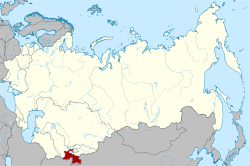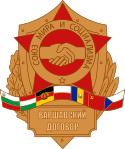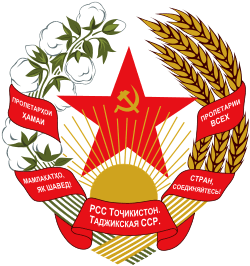Tajik Soviet Socialist Republic
| Tajik Soviet Socialist Republic | ||||||||||
| Таджикская Советская Социалистическая Республика Республикаи Советии Социалистии Тоҷикистон | ||||||||||
| ||||||||||
| ||||||||||
| Anthem Anthem of the Tajik Soviet Socialist Republic | ||||||||||
 Location of the Tajik SSR (red) within the Soviet Union. | ||||||||||
| Capital | Dushanbea | |||||||||
| Languages | Tajik Russian | |||||||||
| Government | Soviet Socialist Republic | |||||||||
| First Secretary | ||||||||||
| • | 1929–1933 | Mirza Davud Huseynov | ||||||||
| • | 1985–1991 | Qahhor Mahkamov | ||||||||
| Chairman of the Council of Ministers | ||||||||||
| • | 1946-1955 | Jabbor Rasulov | ||||||||
| • | 1986-1990 | Izatullo Khayoyev | ||||||||
| History | ||||||||||
| • | Established | 5 December 1929 | ||||||||
| • | Sovereignty declared | 24 August 1990 | ||||||||
| • | Renamed Republic of Tajikistan | 31 August 1991 | ||||||||
| • | Independence declared | 9 September 1991 | ||||||||
| • | Independence recognized | 25 December 1991 | ||||||||
| • | New Constitution | 6 November 1994 | ||||||||
| Area | ||||||||||
| • | 1989 | 143,100 km² (55,251 sq mi) | ||||||||
| Population | ||||||||||
| • | 1989 est. | 5,112,000 | ||||||||
| Density | 35.7 /km² (92.5 /sq mi) | |||||||||
| Calling code | +7 377/379 | |||||||||
| ||||||||||
| Today part of | | |||||||||
| a. | "Stalinabad" between 1929 and 1961. | |||||||||
| Eastern Bloc |
|---|
 |
|
Allied states |
|
Dissent and opposition 1953 uprisings
1956 protests
|
Part of a series on the |
|---|
| History of Tajikistan |
 |
| Timeline |
|
|
The Tajik Soviet Socialist Republic (Tajik SSR; Tajik: Республикаи Советии Социалистии Тоҷикистон, Respuʙlikaji Sovetiji Sotsialistiji Toçikiston; Russian: Таджикская Советская Социалистическая Республика, Tadzhikskaya Sovetskaya Sotsialisticheskaya Respublika), also commonly known as Soviet Tajikistan or simply Tajikistan was one of the constituent republics of the Soviet Union. Located in Central Asia, the Tajik SSR was created on 5 December 1929 as a national entity for the Tajik people within the Soviet Union. It succeeded the Tajik Autonomous Soviet Socialist Republic (Tajik ASSR), which had been created on 14 October 1924 as a part of the predominantly Turkic Uzbek SSR in the process of national delimitation in Soviet Central Asia. On 24 August 1990, the Tajik SSR declared sovereignty in its borders. The republic was renamed to the Republic of Tajikistan on 31 August 1991 and declared its independence from the Soviet Union on 9 September 1991. After the dissolution of the Soviet Union, the state ceased to exist on 6 November 1994 with the adoption of the new Constitution of Tajikistan
Nomenclature
The name Tajik refers to the name of a pre-Islamic tribe that existed before the seventh century A.D. Based on the Library of Congress's 1997 Country Study of Tajikistan, it is difficult to definitively state the origins of the word "Tajik" citing due to its "embroiled in twentieth-century political disputes about whether Turkic or Iranian peoples were the original inhabitants of Central Asia."[1]
| Date | Name |
|---|---|
| 5 December 1929 | Tajik Socialist Soviet Republic |
| 5 December 1936 | Tajik Soviet Socialist Republic |
| 31 August 1991 | Republic of Tajikistan |
History
One of the new states created in the process of national delimitation of Soviet Central Asia in October 1924 was the Uzbek Soviet Socialist Republic – Uzbek SSR or Soviet Uzbekistan. Soviet Tajikistan was created at the same time within the predominantly Turkic Uzbek SSR as an Autonomous Soviet Socialist Republic (Tajik ASSR) – one rank below a Soviet Socialist Republic in USSR geopolitical hierarchy. The new autonomous republic included what had been eastern Bukhara and had a population of about 740,000, out of a total population of nearly 5 million in the Uzbek Soviet Socialist Republic as a whole. Its capital was established in Dyushambe, which had been a village of 3,000 in 1920. In December 1929, Tajik ASSR was detached from the Uzbek SSR and given full status as a Soviet Socialist Republic – Tajik Socialist Soviet Republic. At that time, its capital was renamed Stalinabad, whose named after Joseph Stalin, and the territory that is now northern Tajikistan (Sughd Province) was added to the new republic. Even with the additional territory, the Tajik SSR remained the smallest Central Asian republic. On 5 December 1936, it was renamed to the Tajik Soviet Socialist Republic.
With the creation of a Tajik republic defined in national terms came the creation of institutions that, at least in form, were likewise national. The first Tajik-language newspaper in Soviet Tajikistan began publication in 1926. New educational institutions also began operation at about the same time. The first state schools, available to both children and adults and designed to provide basic education, opened in 1926. The central government also trained a small number of Tajiks for public office, either by putting them through courses offered by government departments or by sending them to schools in the Uzbek SSR.
Under Soviet rule, Tajikistan experienced some economic and social progress. However, living standards in the republic were still among the lowest in the Union. Most people still lived in rural qishlaqs, settlements that were composed of 200 to 700 one-family houses built along a waterway.
After Stalin's death in March 1953, Stalinabad, was renamed to Dushanbe on 10 November 1961 as part of the De-Stalinization program.
In February 1990, tensions between the Tajiks and Armenians squared off in the republic's capital Dushanbe. 26 people died and 565 more were injured and the Soviet troops put down the riots. Both Yaqub Salimov, the Interior Minister and the youth activists were convicted for the participation in the riots.
Later on 24 August 1990, Tajik SSR declared its sovereignty over Soviet laws. By 1991, Tajikistan participated in a referendum in March as part of the attempt to preserve the union with a turnout of 96.85%. However, this did not happened when hardliners took control of Moscow during the next three days in August. After the failure of the coup, the Tajik SSR was renamed to the Republic of Tajikistan on 31 August 1991. On 9 September 1991, Tajikistan seceded from the Soviet Union months before the country itself ceased to exist on 26 December 1991. Conflicts after independence caused a civil war throughout the country over the next six years.
References
- ↑ A Country Study: Tajikistan, Ethnic Background, Library of Congress Call Number DK851 .K34 1997,
- Tajikistan at the Library of Congress Country Studies.
- (Russian) History of Tajik SSR, edited by B. A. Antonenko, Maorif Publ. House, Dushanbe, 1983.
External links
- Tajikistan, land of sunshine by Nazarsho Dodkhudoev.
Coordinates: 38°32′N 68°46′E / 38.533°N 68.767°E


